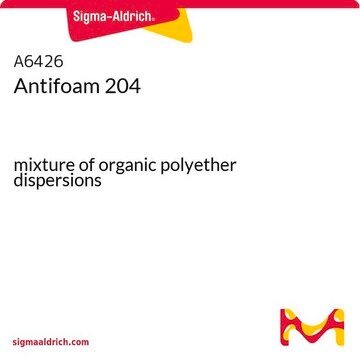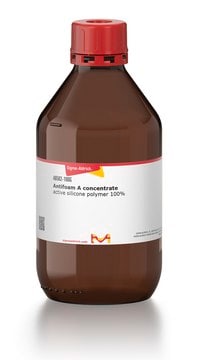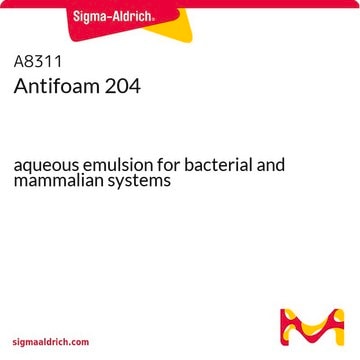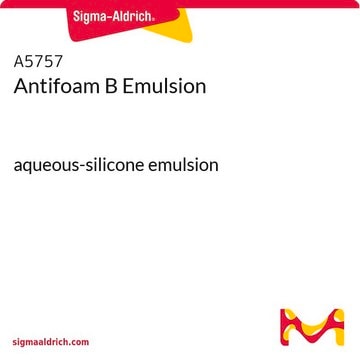Antifoam SE-15 is a 10% emulsion of active silicone polymer and non-ionic emulsifiers. It can be repeatedly sterilized by autoclaving. Antifoam C Emulsion is an aqueous emulsion containing 30% active silicone. Further details about the different properties can be found in the datasheet:
https://www.sigmaaldrich.com/deepweb/assets/sigmaaldrich/product/documents/316/313/a8582pis.pdf
A8582
Antifoam SE-15
aqueous emulsion for bacterial and mammalian systems
Synonym(s):
silicone-based antifoam
About This Item
Recommended Products
Quality Level
form
emulsion (aqueous)
concentration
10% (active silicon)
technique(s)
cell culture | hybridoma: suitable
solubility
H2O: soluble (effective hot or cold.)
density
1.0 g/mL at 25 °C
application(s)
microbiology
storage temp.
room temp
suitability
(Mammalian (suspension))
bacteria (fermentation)
General description
Application
- in the preparation of ramified rolling circle amplification (RAM) amplification buffer.[1]
- to find its effects on cell viability, virus infectivity and PCR (polymerase chain reaction) performance.[2]
- as a constituent of phosphate-buffered saline (PBS) for the determination of total antioxidant status (TAOS) by 2,2′-azino-bis(3-ethylbenzothiazoline-6-sulfonic acid (ABTS) assay. [3]
- as a component of autoinduction expression culture. [4]
- as a component of cyclic adenosine monophosphate (cAMP) detection buffer. [5]
Features and Benefits
- Controls foaming in microbial culture flasks or fermentations
- Non-toxic to the culture medium
- Can be pumped to fermenter on an as-needed basis
Components
Preparation Note
suspensions should be used immediately.
related product
Signal Word
Warning
Hazard Statements
Precautionary Statements
Hazard Classifications
Eye Irrit. 2 - STOT RE 2 Inhalation
Target Organs
Lungs
WGK
WGK 1
Choose from one of the most recent versions:
Already Own This Product?
Find documentation for the products that you have recently purchased in the Document Library.
Customers Also Viewed
-
細胞培養液に添加するためにアンチフォームSE-15の購入を検討しております。この商品は、オートクレーブ可能でしょうか、オートクレーブ可能の場合何回程度が限度でしょうか。 もし可能であれば、アンチフォーム C エマルジョンとの違いも教えていただけないでしょうか。 (アンチフォーム C エマルジョンもオートクレーブ可能でしょうか。) よろしくお願い申し上げます。
1 answer-
Helpful?
-
-
At what concentration is SE-15 (A8582) to be used in bacterial cell culture to control foam?
1 answer-
This Antifoam product is typically used at starting concentrations of 0.01 - 0.02%. Optimization may be required based on variable culture density, ingredients, and conditions. Please see the link below to review the product datasheet for additional information:
https://www.sigmaaldrich.com/deepweb/assets/sigmaaldrich/product/documents/133/175/a8582dat.pdfHelpful?
-
-
I was wondering if you had any information in regards to the stability of antifoam SE-15, A8582. In particular, do you have any data about the stability of this product at pH 8.0? When in a solution, do you have any data on the product stability?
1 answer-
This product is stable at room temperature. Antifoam SE-15 can be pre-diluted with 3-10 parts of cool water to aid in dispersion. Pre-diluted suspensions should be used immediately. The stability of this product is not tested at pH 8.0. If you are looking for antifoams that will be stable at pH 8.0, perhaps you may consider Antifoam A Concentrate (Product A5633 and A6582), They are stable at pH 5.0-9.0. Please see this link for any additional information on Product A8582: https://www.sigmaaldrich.com/deepweb/assets/sigmaaldrich/product/documents/316/313/a8582pis.pdf
Helpful?
-
Active Filters
Our team of scientists has experience in all areas of research including Life Science, Material Science, Chemical Synthesis, Chromatography, Analytical and many others.
Contact Technical Service












